Remembering the lost lives of soldiers in December 2008
By Dhaneshi Yatawara
Today Kilinochchi shows no signs of a war. Just the monument that
stands in the middle of the town to remind that freedom came over lives
of hundreds of valiant men who fought selflessly. This time of the year
in 2008 the Kilinochchi soil was soaked in blood and the air was filled
with painful mourns of the wounded soldiers.
|
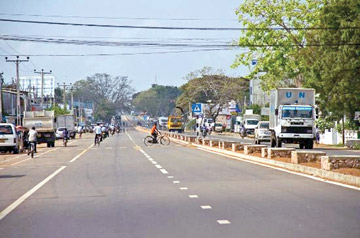
Kilinochchi - now |
The Sri Lankan security forces made supreme sacrifices in liberating
their motherland from the LTTE jackboot. Kilinochchi, the LTTE
headquarters was a ghost town when the Sri Lanka Army troops of the 57
Division marched in January 2009 under the command of General Officer
Commanding Major General Jagath Dias.
The air used to be filled with fear and uncertainty. Broken damaged,
abandoned houses without roofs, blasted water tanks, buildings with
explosives trapped, overgrown home gardens all gave a ghostly feeling to
these towns and villages. When the 58 Division under General Officer
Commanding Major General Shavendra Silva captured Paranthan as the world
approached the dawn of 2009, it was almost a no man's land.
Importance
More than a strategic location Kilinochchi was important to the
Tigers in terms of military operations, it was of a symbolic importance
because it was the de facto capital of Tamil Eelam, the separate state
that the LTTE is fighting for.
The town of Kilinochchi was important for the LTTE because it was the
showcase of the organisation. According to government claims, all civil
administrative affairs were handled by government authorities despite
the LTTE being in control of the town.
The capture of Kilinochchi would have been the greatest blow to the
LTTE which was categorised as the most ruthless terror outfit in the
world without any iota of doubt. Fierce battles erupted in December in
the outskirts of Kilinochchi and Paranthan amidst floods that played
havoc in the battlefront for the past one and half months after the
capture of Pooneryn.
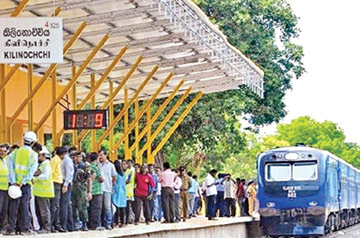 |
|
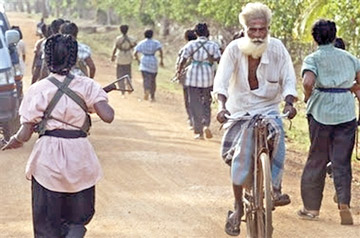
The horrific past with LTTE |
|
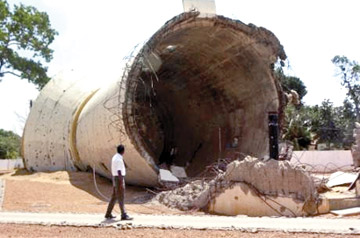
Destroyed water tank |
The initial success of the battles to capture Paranthan and
Kilinochchi came on December 16 as 57 Division and the 58 Division
launched simultaneous attacks on the LTTE's ditch cum bund that has been
constructed defending these two strategic towns from the West of A-9
road.
That was the final barrier that has to be overcome by the troops to
reach either Paranthan or Kilinochchi.
Paranthan was the key target of the 58 Division under the command of
Brigadier Shavendra Silva which captured strategically important
Pooneryn town on the Western coast on November 15, whilst Kilinochchi
was the key target of the 57 Division under the command of Major General
Jagath Dias.
Turning point
Capturing Akkarayankulam in mid October 2008, a large village located
to the southwest of Kilinochchi could be considered as an opening path
cleared by the 57 division. The capture of this village enabled the
troops to attack Kilinochchi from the southwest.
The Iranamadu junction, located to the south of Kilinochchi was also
captured later, that made it possible for the troops to advance towards
Kilinochchi from the south.
Troops from the 57 Division earlier captured several LTTE strongholds
such as Adampan and Kokavil.
The Tigers were using fresh stocks of ammunition unloaded from a ship
operating in the international waters close to Sri Lanka.
Throughout the month of December, the Army conducted three offensives
in an attempt to take Kilinochchi. Heavy monsoon rains affected both
sides during the months of November and December, with floods covering a
large area in and around Kilinochchi. Troop movements were limited by
this, and mines had been scattered around the area by the flood waters.
Throughout the offensive, the Sri Lanka Air Force carried out
numerous air strikes against Kilinochchi in support of the Army's ground
troops.
With the capture of Pooneryn the 58 Division diverted its battlefront
from West to East to advance towards Paranthan and confronted heavily
with the LTTE in the ditch cum bund along with the 57 Division which was
on the Kilinochchi front.
Although a fair number of casualties and deaths were reported from
the Security Forces during the fierce battles in the 57 and 58 Division
fronts troops managed to capture a stretch of earth bund from the North
of Pooneryn Paranthan B-69 Road.
A section of the earth bund had to be given up due to heavy
casualties during the counter attacks of the LTTE. The bad weather and
the flooded terrains made them difficult to operate in the earth bund as
they faced difficulties in casualty evacuation.
No escape
Following the capture of Kilinochchi, the LTTE pushed the escaping
civilians more towards the eastern coast.
This silenced the artillery attack to the other side of the Jaffna
lagoon from Paranthan. Lead by Major General Kamal Gunarathne the 53
Division reached the Elephant Pass gateway to the Northern Peninsula as
year 2009 dawned and the 53 and 58 divisions were united.
There was no escape for the LTTE along the Eastern coast towards
North as troops of the 55 Division under the command of Major General
Prasanna de Silva who manned the eastern coast of the Jaffna Peninsula
bridging every lagoon on the way.
|
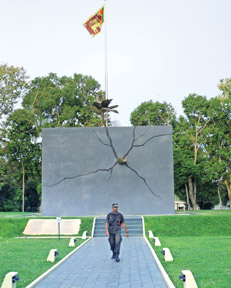
The war monument |
This unity of Army troops was too much for the LTTE to bear. With the
rest of the Army troops strongly holding the rescued grounds and forcing
towards the LTTE from the south and towards the east from the A9 road
the LTTE was compelled to move into a smaller area on the Puthumathalan
coastal line.
It the capture of Kilinochchi that made victory clear and the move
that gave the terrorists a defeating mentality.
Kilinochchi capture gave strength to the Government to stand and tell
the world that the war against terrorism launched under the directives
of President Mahinda Rajapaksa was on right track.
President Mahinda Rajapaksa, announced the capture of Kilinochchi at
the Presidential Secretariat on the eve of January 2, and called for the
LTTE to lay down arms and surrender, stating that this would be the
"final message" to the LTTE.
In his speech, he stated "What our heroic troops have achieved is not
only the capture of the great fortress of the LTTE, but a major victory
in the world's battle against terrorism."
Today there has been a total transformation. Amidst the numerous
allegations and obstructions this island nation walked far away from the
iron fist of terrorism clearing a path to bring the country to a better
position economically, socially and culturally.
All the success was carried on the shoulders of the valiant soldiers
and admirably they still have not put down their duties to rest. |

